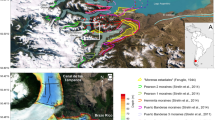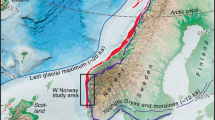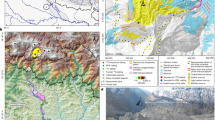Abstract
Many studies involving measurement of the altitudes of fossil marine and lacustrine shorelines have demonstrated glacioisostatic tilting, particularly in North America, Fennoscandia and the British Isles. Such studies are normally illustrated by height–distance diagrams in which fossil shorelines are portrayed as straight lines. In some studies the shoreline-relation diagram is used to analyse and illustrate the altitudinal data1–3: before constructing such a diagram it is assumed that a simple pattern of glacioisostatic uplift has prevailed. Warping of shorelines, as opposed to uniform tilting, has been inferred in North America4–6. On the other hand, Härme7 envisaged block movements in Fennoscandia. Sauramo8 also proposed dislocations, but his interpretation was rejected by Hyyppä9. More recently the concept of the Scandinavian shield as a stable area has been dismissed10,11. Here we provide evidence from Scotland for shoreline dislocation by differential movement of blocks of the Earth's crust.
This is a preview of subscription content, access via your institution
Access options
Subscribe to this journal
Receive 51 print issues and online access
$199.00 per year
only $3.90 per issue
Buy this article
- Purchase on Springer Link
- Instant access to full article PDF
Prices may be subject to local taxes which are calculated during checkout
Similar content being viewed by others
References
Tanner, V. Bull Commn. géol. Finl. 88, 1–594 (1930).
von Post, L. Geol. För. Stockh. Förh. 69, 293–320 (1947).
Synge, F. M. & Stephens, N. Trans. Inst. Br. Geogr. 39, 101–125 (1966).
Goldthwait, J. W. J. Geol. 16, 459–476 (1908).
Leverett, F. & Taylor, F. B. U.S. geol. Surv. Monogr. 53, 529 pp. (1915).
Broecker, W. S. J. geophys. Res. 71, 4777–4783 (1966).
Härme, M. Fennia 89, 29–31 (1964).
Sauramo, M. Suomal. Tiedeakat. Toim. III, 51(1958).
Hyyppä, E. Fennia 89, 37–48 (1964).
Lundqvist, J. & Lagerbäck, R. Geol. För. Stockh. Förh. 98, 45–51 (1976).
Stephansson, O. & Carlsson, H. in Earth Rheology, fsostasy and Eustasy (ed. Mörner, N.-A.) 327–337 (Wiley, Chichester, 1980).
Sissons, J. B. Trans. Inst. Br. Geogr. 55, 145–159 (1972).
Anderson, J. G. C. Trans. R. Soc. Edinb. 63, 15–36 (1956).
Sissons, J. B. J. geol. Soc. Lond. 136, 215–224 (1979).
Author information
Authors and Affiliations
Rights and permissions
About this article
Cite this article
Sissons, J., Cornish, R. Rapid localized glacio-isostatic uplift at Glen Roy, Scotland. Nature 297, 213–214 (1982). https://doi.org/10.1038/297213a0
Received:
Accepted:
Issue Date:
DOI: https://doi.org/10.1038/297213a0
Comments
By submitting a comment you agree to abide by our Terms and Community Guidelines. If you find something abusive or that does not comply with our terms or guidelines please flag it as inappropriate.



